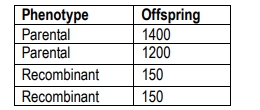Finally, we're discussing mapping in this whole chapter, but this is the video where I'm going to tell you how to determine the locations of genes on a chromosome. Traditionally, the best way to map gene loci is by using recombination frequencies. These are the frequencies of recombinant offspring produced by a cross. These offspring are mixes of the parents, not exact phenotypic replicas, but combinations. So, the formula used here reflects map distance, but you can replace that with recombination frequency if you prefer or if that's what your professor uses. Essentially, they're the exact same thing, either rf, which stands for recombination frequency, or map distance. The formula is expressed as:
number of recombinant offspring total number of offspring × 100This calculation provides the ratio, which when multiplied by 100, gives you the percentage.
I'm going to revisit Morgan's cross. I covered this in the crossing over section previously. If you're confused about how Morgan determined these ratios, I suggest revisiting that video which explains this cross in great detail. Briefly, Morgan crossed homozygous dominant with homozygous recessive, produced two gametes, and thus an F1 generation which was heterozygous dominant for both traits. He then crossed that F1 with a tester and obtained results, which I will summarize:
- Genotypes
- Phenotypes
- Offspring totals
- Types: Parental types resemble the parents, and recombinant types do not.
Using the recombination formula, we find the number of recombinants (151 plus 154) over the total number (2839), multiplied by 100, giving us 10.7%. This value represents both the recombination frequency and the map distance, which we measure in map units (m.u.). The significance of this 10.7 m.u. is that it represents the physical distance on the chromosome, suggesting that the two genes are 10.7 map units apart.
An important concept to remember is that the closer two genes are, the less likely they are to cross over and recombine. Think of this like sitting closely next to a friend in a hallway; it's less likely for someone to sit between you. Conversely, if you are sitting far apart, crossover events are more likely to occur between you.
In exam scenarios, if you're given a recombination frequency of, say, 33%, determine whether the genes are linked. Genes linked have a recombination frequency less than 50%. If the frequency is close to or equal to 50%, linkage is unlikely, indicating independent assortment and ensuring equal allele distribution. Never will the frequency exceed 50% because that would indicate unequal assorting, which contradicts Mendelian genetics.
Remember, linkage occurs if it's less than 50%; it does not occur if equal to 50%, and it will never be greater. So let's have fun with this in mind!



